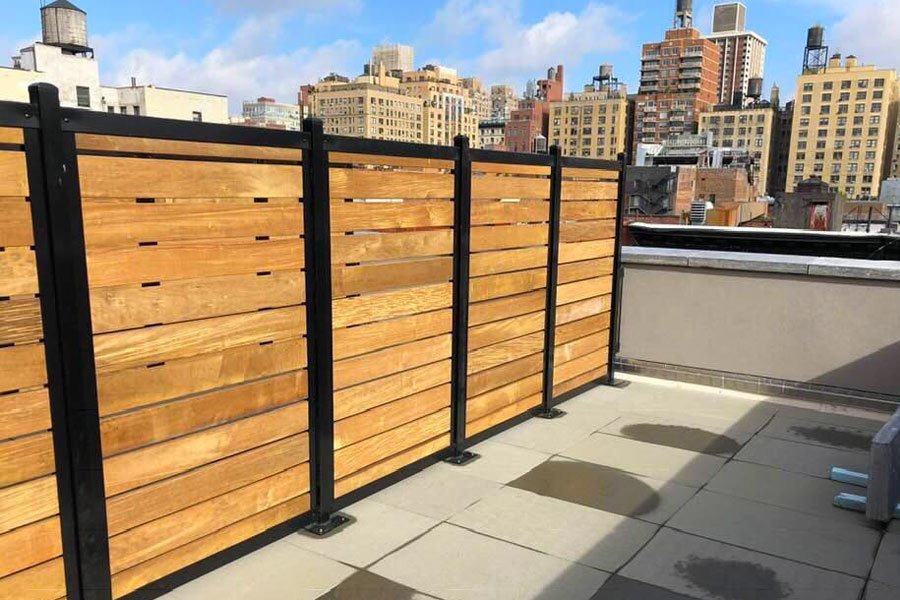Are you in need of some reliable information on fences? Look no further than “http://fencedude.com,” a blog website dedicated to providing comprehensive and engaging content about all things fence-related. With posts that cover various aspects such as different types, sizes, shapes, and materials, this blog strives to educate readers on the pros and cons of different fence options. Whether you’re looking to enhance privacy, ensure security, enclose a backyard, or add decorative elements to your property, you’ll find valuable knowledge and practical advice to help you make informed decisions when selecting and installing fences. So, if you’re interested in learning more about the world of fences, “http://fencedude.com” is the go-to resource!
Q&A:
- What are the benefits of a wooden fence?
- Wooden fences offer natural beauty, versatility, and can be customized to fit your desired aesthetic.
- Are chain-link fences durable?
- Yes, chain-link fences are known for their durability and low maintenance.
- Can vinyl fences withstand harsh weather conditions?
- Vinyl fences are designed to withstand extreme temperatures, high winds, and heavy rain, offering excellent durability.
- What are the advantages of a metal fence?
- Metal fences are highly durable, provide security, and come in various styles and designs.
- How do I maintain a wooden fence?
- Regular cleaning, sealing, and occasional repairs are necessary to maintain the appearance and longevity of a wooden fence.
- Are chain-link fences suitable for residential properties?
- Yes, chain-link fences are commonly used for residential purposes as they are affordable and provide security.
- Is it possible to install a vinyl fence on uneven terrain?
- Yes, vinyl fences can be installed on uneven terrain with the help of adjustable panels and brackets.
- Are metal fences prone to rusting?
- Certain types of metal fences, such as wrought iron, may require occasional maintenance to prevent rusting.
- Can I repaint a wooden fence?
- Yes, wooden fences can be repainted to freshen up their appearance or change the color.
- Do all fence types require a building permit?
- Building permit requirements vary depending on the local regulations and the specifics of the fence installation. It is essential to check with the local authorities before installing a fence.
Pros of Horizontal Slatted Fences
1. Enhanced Aesthetic Appeal
Horizontal slatted fences offer a modern and stylish look to any property. The horizontal orientation of the slats creates a sleek and contemporary design that can instantly elevate the overall aesthetic appeal of your outdoor space. Whether you choose wooden slats for a natural and rustic feel or opt for metal or vinyl slats for a more industrial look, horizontal slatted fences add a touch of elegance to any property.
2. Improved Privacy
Privacy is a top priority for many homeowners, and horizontal slatted fences provide an excellent solution. The closely spaced slats effectively block the view from outside, ensuring that your backyard or outdoor area remains secluded and private. Unlike traditional fences with larger gaps between vertical pickets, horizontal slatted fences minimize the visibility, giving you a sense of seclusion and tranquility within your property.
3. Better Wind Resistance
Horizontal slatted fences are known for their superior wind resistance compared to traditional fences. The horizontal orientation of the slats allows the wind to pass through the gaps rather than pushing against a solid wall-like surface. This design feature helps to reduce the pressure exerted on the fence, making it less susceptible to damage during strong winds or storms.
4. Increased Airflow
Another advantage of horizontal slatted fences is the enhanced airflow they offer. The gaps between the slats promote natural air circulation, preventing the buildup of stagnant air in your outdoor space. This increased airflow can be particularly beneficial in hot and humid climates, providing a cooling effect and making your outdoor area more comfortable.
5. Versatility in Design Options
Horizontal slatted fences offer a wide range of design options to suit different preferences and architectural styles. You can choose from various slat materials such as wood, metal, or vinyl, each offering a different aesthetic appeal and level of durability. Additionally, you have the flexibility to customize the size, spacing, and color of the slats to create a unique and personalized fence design that complements your property.
6. Easy Maintenance
Maintaining a horizontal slatted fence is relatively easy compared to other fence types. The simple design with evenly spaced slats allows for easy access and cleaning. Regular dusting or washing with a hose can keep the fence looking fresh and clean. Additionally, any necessary repairs or touch-ups can be easily addressed due to the straightforward nature of the fence’s construction.
7. Durability
Horizontal slatted fences, when made with high-quality materials and properly installed, can offer excellent durability. Materials like metal or vinyl are resistant to rot, decay, and insect damage, ensuring that your fence withstands the test of time. Even wooden slats, when properly treated and maintained, can provide long-lasting durability. The horizontal orientation of the slats can also help distribute the weight and pressure evenly, reducing the risk of sagging or warping over time.
8. Cost-Effective
Horizontal slatted fences can be a cost-effective option compared to other fence types. The materials used for construction, such as wooden boards or metal slats, are often more affordable than solid panels or intricate designs. Additionally, their relatively simple installation process can help save on labor costs. Whether you are on a budget or looking for an economical fencing solution, horizontal slatted fences offer a great balance between affordability and functionality.
9. Reduced Noise
Horizontal slatted fences have the potential to reduce external noise levels, contributing to a more peaceful and serene outdoor environment. The horizontal orientation of the slats helps in dampening sound waves, making them an excellent choice for properties located near busy streets or other noisy areas. Whether you want to enjoy some quiet time in your backyard or create a serene oasis away from the hustle and bustle, a horizontal slatted fence can help create a more peaceful atmosphere.
10. Quick Installation
Compared to other fence types, horizontal slatted fences can be relatively quick and straightforward to install. Depending on the size of your property and the complexity of the design, professional installers can efficiently complete the installation process. This quick installation time means less disruption to your daily routine and allows you to enjoy the benefits of your new fence sooner.
Cons of Horizontal Slatted Fences
1. Limited View
One drawback of horizontal slatted fences is the limited view they provide. The closely spaced slats can obstruct the view from both inside and outside the property, limiting the visibility of the surroundings. If you have a beautiful view or want to maintain an open and expansive feel in your outdoor space, a horizontal slatted fence may not be the best choice.
2. Lesser Security
While horizontal slatted fences offer improved privacy, they may not provide the same level of security as solid panel fences. The gaps between the slats can allow for easier visibility into your property, potentially attracting unwanted attention or intruders. If security is a top concern, you may need to consider additional measures, such as installing security cameras or incorporating other security features into your fence design.
3. Potential for Animal Intrusion
The gaps between the slats in horizontal slatted fences may allow smaller animals, such as rodents or small dogs, to squeeze through and enter your property. If you have pets or live in an area with a high population of wildlife, you need to be aware of this potential risk. Consider adding additional barriers or mesh to prevent unwanted animal intrusion.
4. Higher Maintenance for Certain Materials
Although horizontal slatted fences are generally easy to maintain, certain materials used for the slats may require more upkeep. For example, wooden slats may need regular staining or sealing to protect them from moisture and extend their lifespan. Metal slats may require occasional cleaning to prevent rusting. It’s important to carefully consider the maintenance requirements of the chosen material to ensure you can provide the necessary care to keep your fence looking its best.
5. Lower Sound Absorption
While horizontal slatted fences can reduce noise levels, they may not offer as much sound absorption as solid panel fences. The gaps between the slats allow some sound transmission, especially at higher frequencies. If noise reduction is a top priority for you, you may need to explore other fence options that provide better sound insulation.
6. Not Suitable for All Climate Conditions
The suitability of horizontal slatted fences can vary depending on the climate conditions in your area. In regions with heavy snow or excessive rainfall, the horizontal orientation of the slats may allow moisture and debris to accumulate, potentially causing damage or warping. Additionally, extreme weather conditions such as hurricanes or strong winds may have a more significant impact on horizontal slatted fences compared to solid panel fences. Consider the specific climate conditions in your area before deciding on a horizontal slatted fence.
7. Difficult for Climbing Plants
If you plan to incorporate climbing plants into your fence design, horizontal slatted fences may present some challenges. The closely spaced slats may not provide enough support for climbing plants to attach and grow properly. You may need to explore alternative trellis systems or modify the design to accommodate climbing plants effectively.
8. Prone to Gradual Weathering and Discoloration
Over time, horizontal slatted fences may be susceptible to gradual weathering and discoloration. The constant exposure to sun, rain, and other elements can cause the materials to fade or wear down. Wooden slats may develop a grayish hue, and metal slats may begin to show signs of rust. Regular maintenance and periodic refinishing or repainting can help minimize these effects.
9. May Require Regular Cleaning
While horizontal slatted fences are generally easy to clean and maintain, the nature of the design may require more frequent cleaning compared to solid panel fences. The gaps between the slats can accumulate dust, dirt, and debris, especially in windy or dusty areas. Regular cleaning with a hose or pressure washer may be necessary to keep your fence looking clean and fresh.
10. Potential Privacy Gaps
Depending on the installation and maintenance, horizontal slatted fences may develop privacy gaps over time. The slats may shift or warp, creating visible spaces between them and compromising the privacy they initially provided. Regular inspections and maintenance can help identify and address any privacy gaps before they become significant issues.

Factors Affecting the Aesthetic Appeal of Horizontal Slatted Fences
When considering horizontal slatted fences for your property, several factors can influence their overall aesthetic appeal and visual impact. Understanding these factors can help you make informed decisions and create a fence design that aligns with your preferences and complements your property.
1. Material Choice
The choice of material for your horizontal slatted fence significantly affects its aesthetic appeal. Different materials, such as wood, metal, or vinyl, offer distinct looks and textures. Wood, for example, provides a warm and natural appearance, while metal exudes a modern and industrial vibe. Consider the overall style and architecture of your property when selecting the material to ensure a cohesive and harmonious aesthetic.
2. Slats Size and Spacing
The size and spacing of the slats play a crucial role in the design and overall aesthetic of a horizontal slatted fence. Wide slats with larger gaps create a more open and airy feel, while narrower slats with minimal spacing offer a more solid and substantial look. Consider the visual impact you want to achieve and how it aligns with the overall style of your property.
3. Fence Height and Length
The height and length of your horizontal slatted fence can significantly impact its aesthetic appeal. Taller fences can create a more imposing and secure feel, especially for larger properties. On the other hand, shorter fences can maintain an open and inviting atmosphere. Consider the scale and proportion of your property, as well as any local regulations or restrictions, when determining the appropriate height and length for your fence.
4. Color and Finish
The color and finish of your horizontal slatted fence can dramatically impact its visual appeal. Natural wood tones can provide a warm and organic feel, while painted or stained finishes can offer a more contemporary or vibrant look. Ensure that the color and finish you choose complement the existing color palette of your property and surrounding landscape.
5. Decorative Elements
Adding decorative elements to your horizontal slatted fence can enhance its aesthetic appeal and make it a standout feature of your property. Consider incorporating decorative caps, finials, or lattice panels to add visual interest and create a customized look. Just ensure that the decorative elements align with the overall style and design of your property for a cohesive aesthetic.
Enhanced Privacy with Horizontal Slatted Fences
Privacy is often a top concern for homeowners, and horizontal slatted fences excel in providing enhanced privacy. Here are some ways in which horizontal slatted fences can enhance your privacy:
1. Reduced Visual Exposure
Horizontal slatted fences are designed specifically to minimize visual exposure. The closely spaced slats create a solid barrier that obstructs the view from outside your property. Whether you want to enjoy your backyard without prying eyes or create a private outdoor oasis, a horizontal slatted fence can help achieve that coveted seclusion.
2. Obstruction of Line of Sight
The horizontal orientation of the slats in these fences obstructs the line of sight, making it difficult for passersby or neighbors to observe your activities. The tight spacing and placement of the slats create a sense of security and privacy, allowing you to enjoy your outdoor space without feeling constantly exposed.
3. Noise Reduction
In addition to visual privacy, horizontal slatted fences also offer some degree of noise reduction. The solid barrier created by the slats helps block out external noise, providing you with a quieter and more peaceful outdoor environment. Whether you live on a busy street or in a noisy neighborhood, a horizontal slatted fence can help create a more serene and tranquil atmosphere.
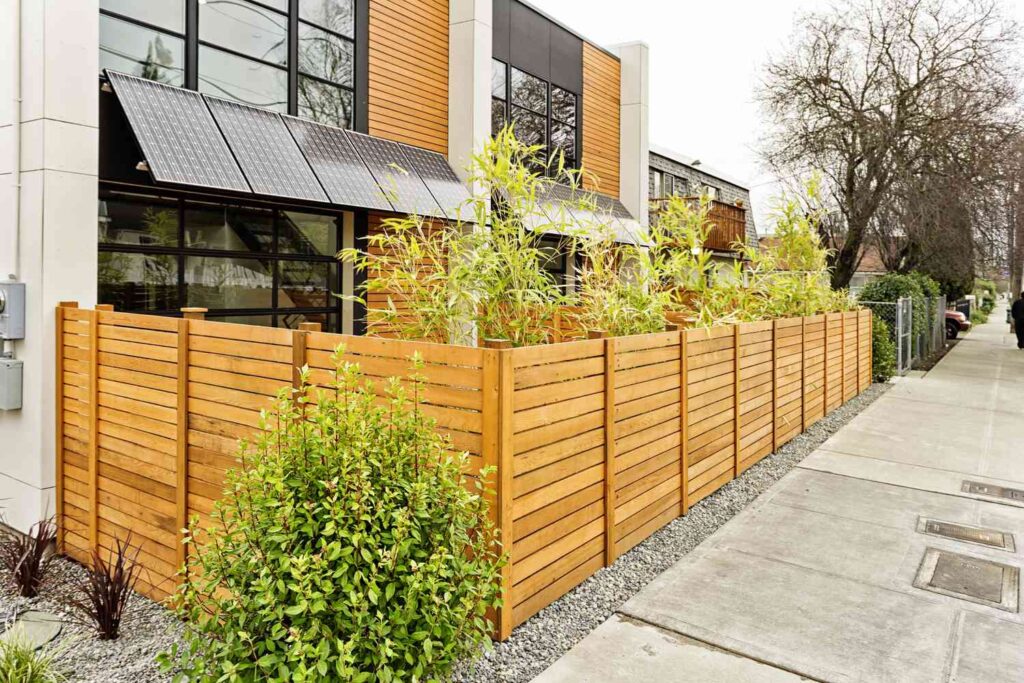
Improved Wind Resistance of Horizontal Slatted Fences
Horizontal slatted fences offer better wind resistance compared to traditional fence designs. Here’s how these fences excel in wind resistance:
1. Wind Passage between Slats
One of the key factors contributing to the improved wind resistance of horizontal slatted fences is the presence of gaps between the slats. Unlike solid panel fences, which act as a solid barrier to wind, the gaps in horizontal slatted fences allow air to pass through. This design feature reduces the force of the wind against the fence, minimizing the risk of damage during strong winds or storms. The wind can easily flow through the gaps without exerting excessive pressure on the structure.
2. Reduction of Wind Pressure
When winds blow against a traditional solid panel fence, they exert significant pressure on the face of the fence. This pressure can lead to structural damage or even uprooting in severe cases. In horizontal slatted fences, the wind can pass through the gaps between the slats, reducing the build-up of pressure on the fence surface. The innovative design disperses the force of the wind, making horizontal slatted fences more resistant to damage caused by strong winds.
Increased Airflow with Horizontal Slatted Fences
Horizontal slatted fences offer the advantage of increased airflow in your outdoor space. Here’s why these fences excel in promoting airflow:
1. Natural Ventilation
The gaps between the slats in horizontal slatted fences allow for natural ventilation. The free movement of air prevents the accumulation of stagnant air, making your outdoor space more comfortable and enjoyable. Especially in hot and humid climates, increased airflow provided by horizontal slatted fences can help keep your outdoor area cool and refreshing.
2. Prevention of Stagnant Air
Stagnant air can be a breeding ground for mosquitos and other insects, making your outdoor space less inviting. The design of horizontal slatted fences promotes the circulation of air, discouraging the buildup of stagnant air pockets. This can help create a more pleasant environment on your property and reduce the presence of annoying insects.
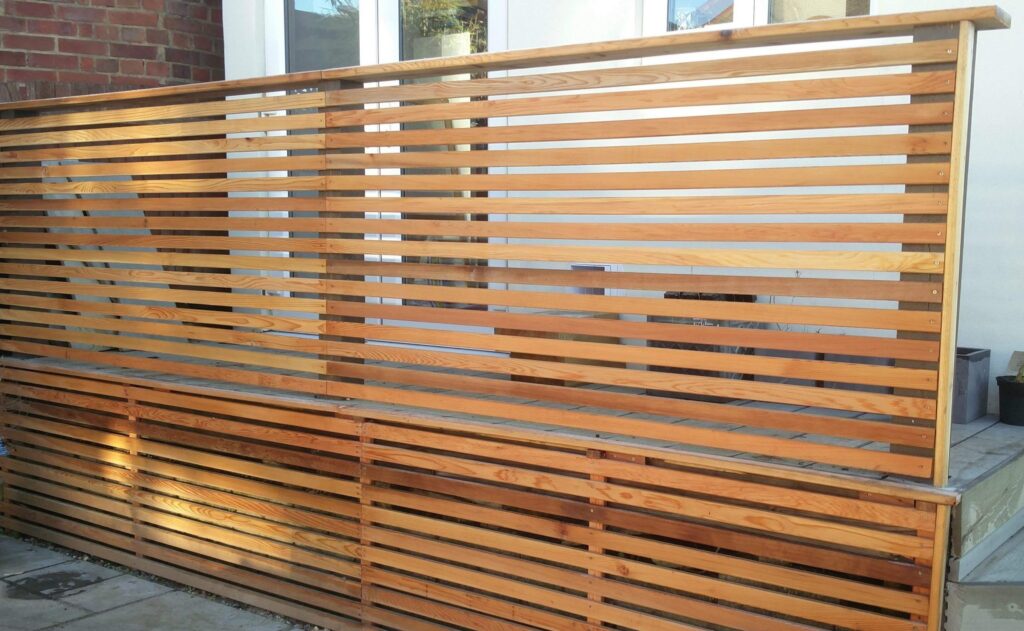
Versatility in Design Options for Horizontal Slatted Fences
One of the key advantages of horizontal slatted fences is the versatility they offer in terms of design options. Here are some ways you can customize your horizontal slatted fence:
1. Different Slats Patterns
Horizontal slatted fences allow for various slat patterns, enabling you to create a unique and personalized design. You can choose different orientations for your slats, such as alternating directions or varying widths. These patterns not only add visual interest but also contribute to the overall aesthetic appeal of your fence.
2. Modular Design
Horizontal slatted fences can be easily customized and modified to suit different needs and preferences. The modular design allows for easy installation, removal, and replacement of slats, making it convenient to adapt the fence to changing requirements. Whether you want to add a gate or incorporate decorative elements, the modular nature of these fences provides the flexibility to tailor the design to your specifications.
3. Combination with Other Materials
Horizontal slatted fences can be combined with other materials to create a unique and eye-catching design. For example, combining wood slats with metal posts or incorporating glass panels between the slats can add a contemporary and sleek look to your fence. The versatility in material combinations allows you to explore different textures and finishes, resulting in a fence that seamlessly integrates with your property’s architecture and style.
4. Multiple Color Options
Horizontal slatted fences offer a variety of color options to suit different aesthetic preferences. Whether you prefer the natural warmth of wood tones, the sleekness of black metal slats, or the clean look of white vinyl, you can choose a color that complements your property’s exterior. The availability of numerous color options ensures that your horizontal slatted fence seamlessly integrates into your overall design scheme.
Easy Maintenance of Horizontal Slatted Fences
Maintaining a horizontal slatted fence is generally straightforward and easy. Here are some maintenance tips to keep your fence looking its best:
1. Cleaning and Washing
Regular cleaning is essential to maintain the visual appeal of your horizontal slatted fence. Dust and debris can accumulate in the gaps between the slats, making the fence look dull and dirty. Use a hose or pressure washer to wash away any dirt and grime. For stubborn stains, use a mild detergent or a specialized fence cleaner. Regular cleaning sessions will help keep your fence looking clean and fresh.
2. Periodic Inspections and Repairs
Performing regular inspections is crucial to identify and address any maintenance issues promptly. Check for loose or damaged slats, weakened posts, or any signs of wear and tear. Replace any broken or warped slats and reinforce any unstable areas. By addressing issues early on, you can prevent further damage and prolong the lifespan of your fence.
3. Stain and Paint Touch-Ups
If you have a wooden horizontal slatted fence, periodic staining or painting can help protect the wood from moisture and UV damage. Inspect the slats for any signs of fading, peeling, or discoloration, and touch up those areas with appropriate stain or paint. This maintenance step will preserve the longevity and appearance of your fence.
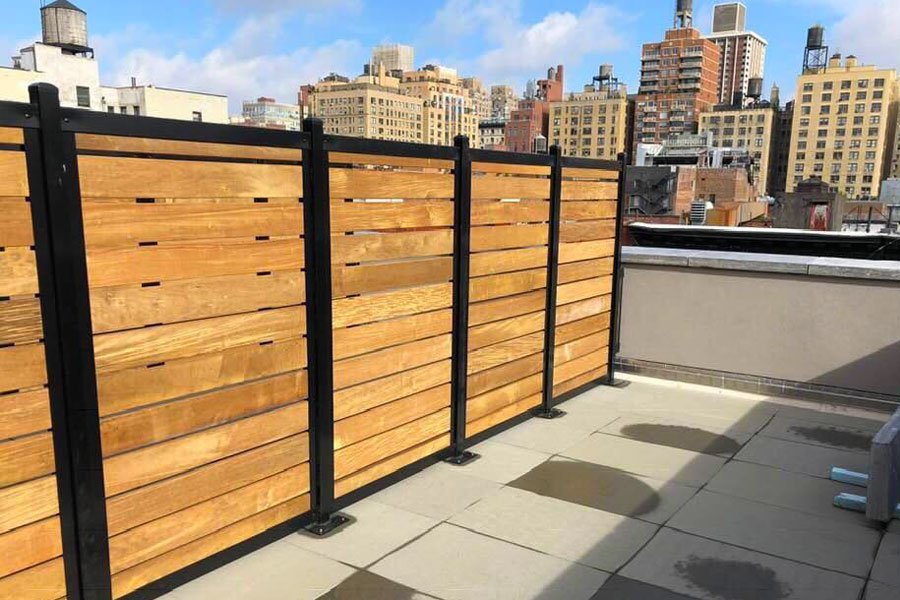
Durability of Horizontal Slatted Fences
Horizontal slatted fences can offer excellent durability when constructed with high-quality materials and proper installation. Here’s how you can ensure the longevity of your horizontal slatted fence:
1. Choice of High-Quality Materials
The durability of any fence relies heavily on the quality of the materials used. Opt for durable and weather-resistant materials such as pressure-treated wood, aluminum, or vinyl. These materials are designed to withstand the elements and resist rot, decay, and insect damage. By investing in high-quality materials, you can ensure that your horizontal slatted fence lasts for years to come.
2. Proper Installation
Proper installation is crucial for the long-term durability of a horizontal slatted fence. Ensure that the fence is installed according to the manufacturer’s instructions or by a professional fence contractor. Properly secured posts, even spacing of slats, and adequate reinforcement will help prevent sagging, warping, or instability over time.
3. Regular Maintenance
Regular maintenance is essential to extend the lifespan of your horizontal slatted fence. Follow the maintenance guidelines specific to the material used (such as sealing or staining for wood) and perform routine inspections for any signs of damage or wear. Addressing maintenance issues promptly will prevent further deterioration and ensure that your fence remains durable and structurally sound.
Cost-Effectiveness of Horizontal Slatted Fences
Horizontal slatted fences can be a cost-effective option for homeowners. Here’s why:
1. Lower Material Costs
Compared to some other fence types, horizontal slatted fences can be more cost-effective in terms of materials. The construction of these fences typically requires fewer materials overall, as the slats are spaced apart rather than forming a solid panel. Materials such as wood, metal, or vinyl used for the slats are often more affordable than large panels or intricate designs. This lower material cost can make horizontal slatted fences a budget-friendly choice.
2. Reduced Installation Expenses
The installation of horizontal slatted fences can be less labor-intensive compared to other fence types, resulting in reduced installation expenses. Depending on the design and complexity of the fence, professional installers can complete the installation process relatively quickly. This efficiency translates into cost savings for homeowners, making horizontal slatted fences a cost-effective option.
3. Potential Long-Term Savings
Horizontal slatted fences can offer potential long-term savings in terms of maintenance and repairs. With proper maintenance and routine inspections, you can identify and address issues early, preventing costly repairs or replacements down the line. Additionally, the durability of horizontal slatted fences can reduce the need for frequent replacement, further saving costs in the long run.
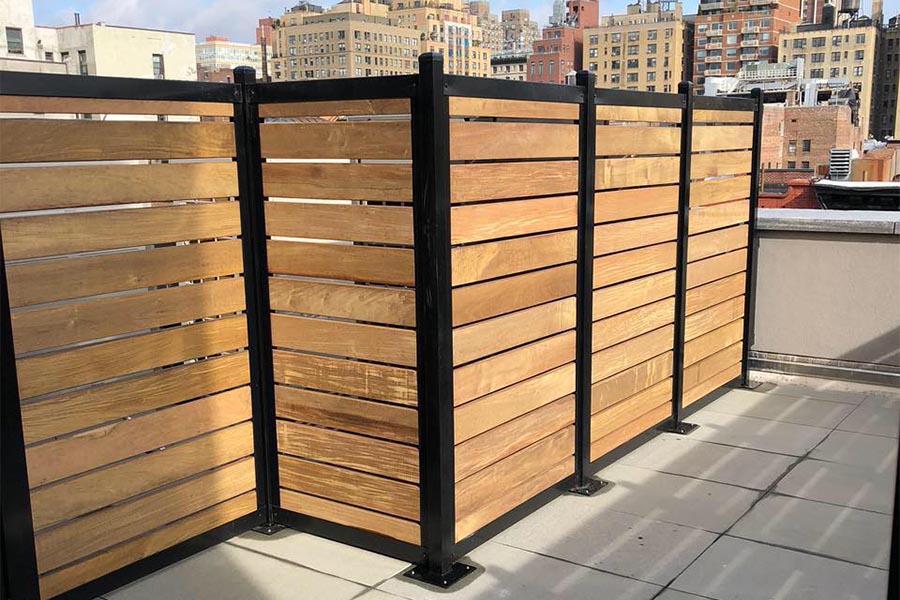
Noise Reduction Benefits of Horizontal Slatted Fences
While providing enhanced privacy, horizontal slatted fences also offer advantages in reducing noise levels. Here’s how they can help:
1. Dampening Sound Waves
The structure of horizontal slatted fences helps dampen sound waves, reducing the amount of noise that enters your property. The closely spaced slats act as a barrier to sound transmission, minimizing the impact of external noise sources. Whether you are located near a busy road, commercial area, or construction site, a horizontal slatted fence can provide a more peaceful and quiet environment.
2. Improved Acoustic Privacy
The privacy provided by horizontal slatted fences also contributes to improved acoustic privacy. By blocking visual access, these fences create a psychological barrier that reduces the perceived noise levels. When you have a sense of privacy, external noise can become less intrusive, making your outdoor space more enjoyable and serene.
Potential Privacy Gaps in Horizontal Slatted Fences
Over time, horizontal slatted fences may develop privacy gaps due to various factors. Here are some potential reasons for privacy gaps and how to address them:
1. Uneven Slat Installation
If the slats are not evenly installed or spaced during the fence construction, privacy gaps may occur. To address this issue, conduct regular inspections and ensure that all slats are securely and evenly spaced. Replace any damaged or improperly installed slats to maintain the desired level of privacy.
2. Maintenance Issues
Lack of regular maintenance or inadequate repairs can contribute to privacy gaps in horizontal slatted fences. The shifting or warping of slats over time can create visible spaces, compromising the privacy they initially provided. To prevent privacy gaps, perform routine maintenance, including visual inspections, and address any maintenance issues promptly. This will help ensure that your fence remains in good condition and maintains the desired level of privacy.
10 Common Questions about Horizontal Slatted Fences:
- Are horizontal slatted fences suitable for both residential and commercial properties?
- Yes, horizontal slatted fences can be used in both residential and commercial properties. The versatile design options and functional benefits make them suitable for various applications.
- How do I choose the right material for my horizontal slatted fence?
- The material choice depends on factors such as durability, budget, and aesthetic preferences. Consider the advantages and disadvantages of materials like wood, metal, and vinyl to make an informed decision.
- Can I use climbing plants with a horizontal slatted fence?
- While it may be more challenging, climbing plants can be used with horizontal slatted fences. You may need to incorporate additional support structures or use certain trellis systems to facilitate the growth of climbing plants.
- Will a horizontal slatted fence reduce noise from a nearby road?
- Yes, horizontal slatted fences can help reduce noise from a nearby road. The solid barrier created by the slats helps block out external noise, providing a quieter outdoor environment.
- Do horizontal slatted fences require a lot of maintenance?
- Horizontal slatted fences generally require minimal maintenance. Regular cleaning, inspections, and occasional repairs or touch-ups are usually sufficient to keep them looking their best.
- Can I install a horizontal slatted fence myself, or should I hire a professional?
- The installation of a horizontal slatted fence can be done by yourself if you have the necessary skills and tools. However, for a more efficient and precise installation, it’s recommended to hire a professional fence contractor.
- How long do horizontal slatted fences typically last?
- The lifespan of a horizontal slatted fence depends on factors such as the quality of materials, installation, and maintenance. With proper care, these fences can last for several years or even decades.
- Are horizontal slatted fences suitable for high wind areas?
- Horizontal slatted fences offer improved wind resistance compared to traditional fences. However, in high wind areas, it’s essential to choose durable materials and ensure proper installation to minimize the risk of damage.
- Can I customize the design of my horizontal slatted fence?
- Yes, horizontal slatted fences offer a wide range of design options. You can customize the slat size, spacing, material, and color to create a unique and personalized fence design.
- Are horizontal slatted fences more expensive than other fence types?
- The cost of a horizontal slatted fence depends on factors such as the chosen material, fence size, and any additional features. In general, horizontal slatted fences can be a cost-effective option compared to other fence types, especially when considering the materials used and installation expenses.
Table Format:
| Pros of Horizontal Slatted Fences | Cons of Horizontal Slatted Fences |
|---|---|
| Enhanced Aesthetic Appeal | Limited View |
| Improved Privacy | Lesser Security |
| Better Wind Resistance | Potential for Animal Intrusion |
| Increased Airflow | Higher Maintenance for Certain Materials |
| Versatility in Design Options | Lower Sound Absorption |
| Easy Maintenance | Not Suitable for All Climate Conditions |
| Durability | Difficult for Climbing Plants |
| Cost-Effective | Prone to Gradual Weathering and Discoloration |
| Reduced Noise | May Require Regular Cleaning |
| Quick Installation | Potential Privacy Gaps |
